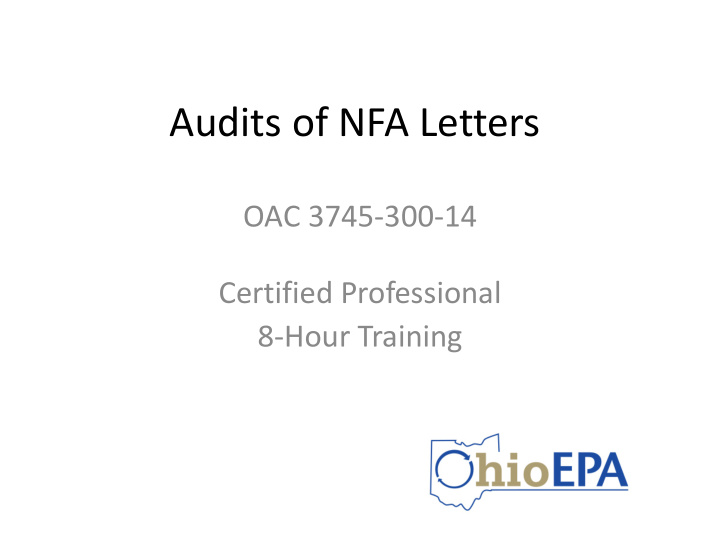



Audits of NFA Letters OAC 3745 ‐ 300 ‐ 14 Certified Professional 8 ‐ Hour Training
Audits of NFAs • Performed annually on NFA letters submitted during the prior calendar year in request of a CNS • Performed by the Ohio EPA – Required by statute to audit at least 25% of the NFA letters submitted during the previous calendar year • Certified professionals, certified labs, and volunteers may all be called upon to provide detailed information to the Ohio EPA
Purposes of NFA Audits I. Property: Determine if property for which voluntary action was completed meets applicable standards II. CP: Determine if CPs possessed qualifications required for certification and review the work performed III. CL: Determine if CLs possessed qualifications required to perform VAP certified analyses under VAP and review the work performed
VAP 5 year – Rule 14 - Proposals NFA letters that requested a Did the NFA letter MOA NFAs with risk assessment or remedy CNS during the previous property participate in Yes calendar year the MOA track? No Random Audit Pool – Divided into two groups: group A with a remedy and group B without a remedy Randomly select Not Selected NFA letters from groups A & B Selected VAP Audit Committee: Selects NFA letters for audit Discretionary Audit Pool based on selection criteria Conduct audits of 25% of the previous ‐‐‐ CNS Compliance Audits ‐‐‐ NFA letters with CNS compliance year’s NFA letters from the Random related issues (any NFA letter with a and Discretionary Audit Pools CNS – usually issue specific)
Which NFAs Get Audited? • After submission, NFA Letters will fall into one of two audit pools or categories: random or discretionary • An NFA Letter may be audited in the form of a compliance audit, should a compliance issue arise
Which NFAs Get Audited? • Random Audit Pool: All NFA letters that are submitted with a request for a CNS will be placed in this pool • Except NFAs that were taken through the MOA track…those NFAs are exempt from being selected for random audit.
Which NFAs Get Audited? The Random audit pool is divided into two groups: • NFA Letters with a remedy • NFA Letters without a remedy
Which NFAs Get Audited? • NFA Letters that were not selected for random audit will then fall into the discretionary audit pool. • All MOA track NFA Letters will also be placed in the discretionary audit pool.
Compliance Audits • If a compliance issue should arise with a property, a compliance audit may be conducted.
Other Factors in Selecting NFAs from the Audit Pool • From the entire selection of NFA Letters that were received the previous year, at least 25% of the NFAs that involve some remedial activities must be selected • and…at least 25% of the NFAs that do not involve remedial action must be selected
Tier I & Tier II Audits Two procedures: Tier I Audit • Review and analysis of documents involving NFA • Visual Inspection of the Property
Tier I & Tier II Audits II. Tier II Audit • Physical inspection of property • May include sampling of soil, ground water, surface water, or sediments at property on which NFA was based
Reasons for Tier II Audits The focus of a tier II audit is to collect data to demonstrate whether the property meets applicable standards. I. Information from Tier I Audit not sufficient to evaluate NFA II. Potential fraud suspected III. At Ohio EPA discretion
Audit Costs • There are no direct costs charged to the volunteer, CP, or CL − Costs to conduct an audit are already accounted for in the NFA fee charged to the volunteer when requesting a CNS • Options where additional costs could apply: – split sampling – CP time and expenses??
Report of Audit Findings • Findings should be completed by December 31 st of the calendar year in which the NFA letter was selected for audit. • Audit Report ideally issued by March of following year • Audit completion timing is not as strict
Potential Negative Consequences of Audits I. CP or CL could face disciplinary actions II. CNS could be voided for violation of an environmental covenant III. CNS could be revoked on the property where voluntary action was performed ‒ Per the CNS, revocation is not automatic, the Agency will always provide the volunteer an opportunity to cure the non ‐ compliance
Conclusions • New rules result in more transparency in the audit process • The most basic audit procedures remain unchanged
Recommend
More recommend